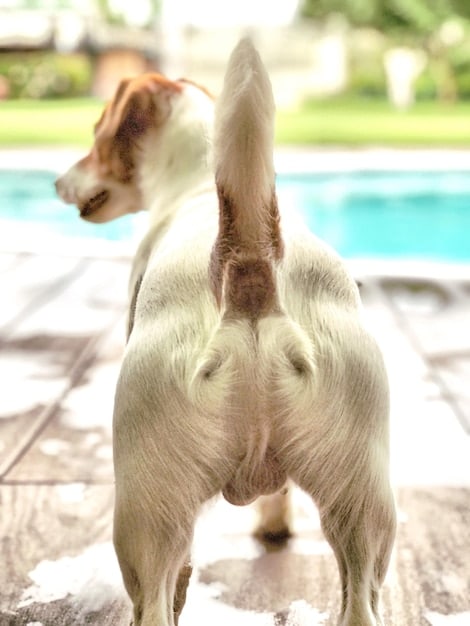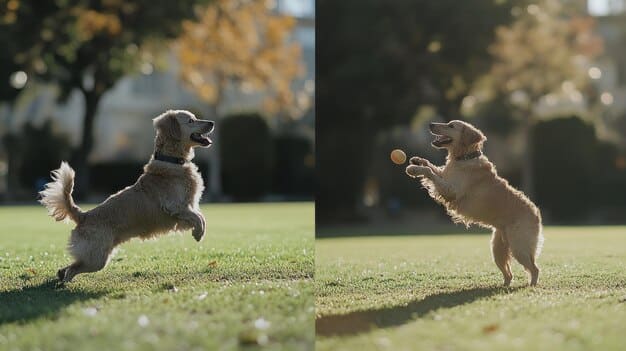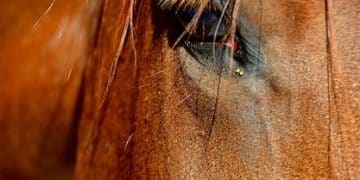Decode Dog Tail Wags: 5 Hidden Emotion Shifts in 2025

Decoding canine tail wags in 2025 involves understanding five subtle shifts in wagging patterns – speed, direction, height, width, and accompanying body language – to accurately gauge a dog’s emotional state, from happiness to anxiety.
Ever wondered what your furry friend is really trying to tell you with their tail? Decoding canine tail wags: 5 subtle shifts that reveal hidden emotions in 2025 is about understanding the nuances beyond a simple wag, offering insights into your dog’s feelings.
Understanding the Basics of Canine Communication
Dogs communicate in various ways, and tail wagging is one of the most prominent. However, it’s not as simple as “a wagging tail means a happy dog.” Understanding the basics of canine communication is crucial to accurately interpret what your furry friend is trying to say.
Canine communication involves a combination of body language, vocalizations, and scent marking. Tail wags are just one piece of the puzzle, and they need to be interpreted in context with other signals.
The Myth of the Happy Wag
Many people assume that a wagging tail always indicates happiness. This is a dangerous oversimplification. A wagging tail simply means that the dog is emotionally aroused. The emotion could be positive, such as happiness, but it could also be negative, such as fear or aggression.
Reading the Whole Dog
To accurately interpret a dog’s tail wag, you need to consider the entire dog. Look at their posture, facial expressions, and the position of their ears and body. Are they relaxed or tense? Is their mouth open or closed? Are they making eye contact or avoiding it?
- Posture: A relaxed dog will have a loose, natural posture. A tense dog might be stiff or crouched down.
- Facial Expressions: A happy dog might have a relaxed mouth and soft eyes. A fearful dog might have a furrowed brow and whale eye (when you can see the whites of their eyes).
- Ear Position: Ears that are forward or relaxed usually indicate alertness or happiness. Ears that are pinned back can indicate fear or submission.
By considering all these factors, you can get a much clearer picture of what your dog is trying to communicate. Always approach a dog cautiously, especially if you are unfamiliar with them, and be mindful of their body language.
Understanding the basics of canine communication sets the stage for a more nuanced understanding of tail wags, allowing you to better interpret the subtle shifts that reveal hidden emotions.
The Speed of the Wag: Excitement vs. Anxiety
The speed of a dog’s tail wag can tell you a lot about the intensity of their emotions. A fast wag typically indicates excitement or high arousal, while a slow wag often suggests uncertainty, anxiety, or lower energy levels.
It’s essential to distinguish between different speeds and pair them with other body language cues to decode the specific emotion accurately.
Fast Wag: High Energy and Excitement
A rapidly wagging tail usually indicates that the dog is highly excited or happy. This type of wag is often accompanied by a playful bounce in their step, a relaxed mouth, and bright eyes.
For example, a dog might show a fast wag when their favorite person comes home, when they see their leash for a walk, or when they are playing with a beloved toy. The intensity of the wag often correlates with the intensity of their excitement.
Slow Wag: Caution and Uncertainty
A slow, deliberate wag can indicate a range of emotions, from mild interest to anxiety. A dog might wag slowly when they are unsure about a new person or situation, or when they are feeling submissive.
In some cases, a slow wag can also indicate pain or discomfort. Always observe your dog’s overall behavior and check for any signs of injury or illness if they are exhibiting a slow wag without a clear trigger.

The speed of the wag is not a standalone indicator. Pay attention to the dog’s posture, facial expressions, and the context of the situation to get a full understanding of their emotional state.
Direction Matters: Right vs. Left Wags
Recent research suggests that the direction of a dog’s tail wag can indicate different emotional states. A wag biased to the right (from the dog’s perspective) often indicates positive emotions, while a wag biased to the left can signal negative feelings.
This fascinating discovery provides another layer of insight into canine communication, although it requires careful observation.
Right-Biased Wag: Positive Emotions
When a dog experiences positive emotions, such as happiness or excitement, their tail wag tends to be more pronounced on the right side of their body (from their perspective). This is thought to be related to brain lateralization, where the left hemisphere (associated with positive emotions) controls the right side of the body.
A right-biased wag might be observed when a dog sees their owner, receives praise, or anticipates a treat. This type of wag is often accompanied by a relaxed posture and a happy expression.
Left-Biased Wag: Negative Emotions
Conversely, when a dog experiences negative emotions, such as fear or anxiety, their tail wag may be more pronounced on the left side of their body. This is because the right hemisphere of the brain (associated with negative emotions) controls the left side of the body.
A left-biased wag might be seen when a dog encounters a stranger, feels threatened, or hears a loud noise. This type of wag is often accompanied by a tense posture, flattened ears, and a furrowed brow.
- Subtleties: The direction bias can be subtle and hard to notice without careful observation.
- Individual Variation: Some dogs may show a more pronounced bias than others.
- Context: Always consider the context and the dog’s overall body language when interpreting the direction of the wag.
Paying attention to the direction of your dog’s tail wagging can provide valuable insights into their emotional state, helping you better understand and respond to their needs.
Height and Posture: Confidence vs. Submission
The height at which a dog holds their tail, combined with their overall posture, can indicate their level of confidence or submission. A high tail carriage often suggests confidence and dominance, while a low tail carriage usually indicates submission or anxiety.
Observing the tail height in conjunction with other body language cues is essential for accurate interpretation.
High Tail: Confidence and Dominance
A dog holding their tail high, often erect or slightly curved over their back, typically indicates confidence and a sense of dominance. This posture is often seen in dogs who are sure of themselves and their environment.
A high tail might be displayed when a dog is patrolling their territory, greeting familiar individuals, or attempting to assert themselves in a social situation. It is usually accompanied by an upright posture and direct eye contact.
Low Tail: Submission and Anxiety
A dog holding their tail low, often tucked between their legs, usually indicates submission, anxiety, or fear. This posture is a sign that the dog is feeling insecure or threatened.

Tucking the tail is a clear signal of discomfort or submission. The behavior may be paired with other signals, such as lowered ears, avoiding eye contact, or trembling.
When assessing demeanor, remember that tail height and carriage must be considered alongside overall posture. Taken alone, it can suggest emotions that are incorrect.
Tail Width and Movement: Intensity of Emotion
The width and range of a dog’s tail movement can also provide clues about the intensity of their emotions. A wide, sweeping wag often indicates a genuine and strong emotion, while a narrow, restrained wag might suggest a more subdued or uncertain feeling.
Observing how widely and freely a dog wags their tail can help you gauge the depth of their emotional response.
Wide, Sweeping Wag: Genuine Excitement
A wide, sweeping wag that involves the entire tail and even the hips often indicates genuine excitement and happiness. This type of wag is a sign that the dog is fully engaged and expressing their joy without reservation.
A wide wag might be seen when a dog is playing with their favorite toy, running in an open field, or greeting a beloved friend. It’s a clear indication that the dog is having a great time.
Narrow, Restrained Wag: Subdued Emotion
A narrow, restrained wag, where the tail moves only slightly and doesn’t cover a wide range, can indicate a more subdued or uncertain emotion. This type of wag might be a sign that the dog is feeling cautious, anxious, or unsure about the situation.
In conclusion, the analysis of tail width in combination with other physical signals will greatly contribute to being able to decode emotion.
| Key Aspect 🐶 | Brief Description 📝 |
|---|---|
| Wag Speed 🐾 | Fast indicates excitement; slow suggests caution or anxiety. |
| Direction 🐕 | Right bias for positive emotions, left for negative. |
| Tail Height 🐩 | High indicates confidence, low signals submission or fear. |
| Wag Width 🦴 | Wide swiping emotion indicates big happiness or excitement while narrow and restrained wags mean subdued emotion. |
Frequently Asked Questions
▼
No, a wagging tail indicates arousal or an emotional state, not necessarily happiness. It can also signify fear, anxiety, or aggression depending on other cues.
▼
The direction is significant; a right bias (from the dog’s view) often suggests positive emotions, while a left bias can indicate negative feelings, but isn’t a standalone indicator.
▼
Tucking the tail typically indicates submission, fear, or anxiety. The dog is likely feeling insecure or threatened and is trying to make itself appear smaller.
▼
Tail length doesn’t change the interpretation of wags but might make subtleties harder to observe. Focus on the movement and other body language regardless of length.
▼
No, always consider the whole picture. Look at ear position, body posture, facial expressions, and the context of the situation to get an accurate understanding of your dog’s mood.
Conclusion
Understanding the subtle shifts in canine tail wags in 2025 involves considering speed, direction, height, width, and accompanying body language. These insights provide a richer understanding of your dog’s emotions, fostering stronger bonds and better communication.



